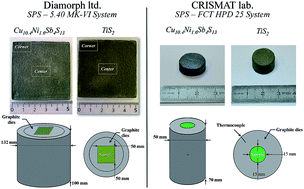Up-scaled synthesis process of sulphur-based thermoelectric materials†
Abstract
The scale up of Spark Plasma Sintering (SPS) for the consolidation of large square monoliths (50 × 50 × 3 mm3) of thermoelectric materials is demonstrated and the properties of the fabricated samples compared with those from laboratory scale SPS. The SPS processing of n-type TiS2 and p-type Cu10.4Ni1.6Sb4S13 produces highly dense compacts of phase pure material. Electrical and thermal transport property measurements reveal that the thermoelectric performance of the consolidated n- and p-type materials is comparable with that of material processed using laboratory scale SPS, with ZT values that approach 0.75 and 0.35 at 700 K for Cu10.4Ni1.6Sb4S13 and TiS2, respectively. Mechanical properties of the consolidated materials show that large-scale SPS processing produces highly homogeneous materials with hardness and elastic moduli that deviate little from values obtained on materials processed on the laboratory scale. More generally, the process described in this paper is a promising way to produce high performance thermoelectric materials with square geometry, specifically required for thermoelectric device production.


 Please wait while we load your content...
Please wait while we load your content...